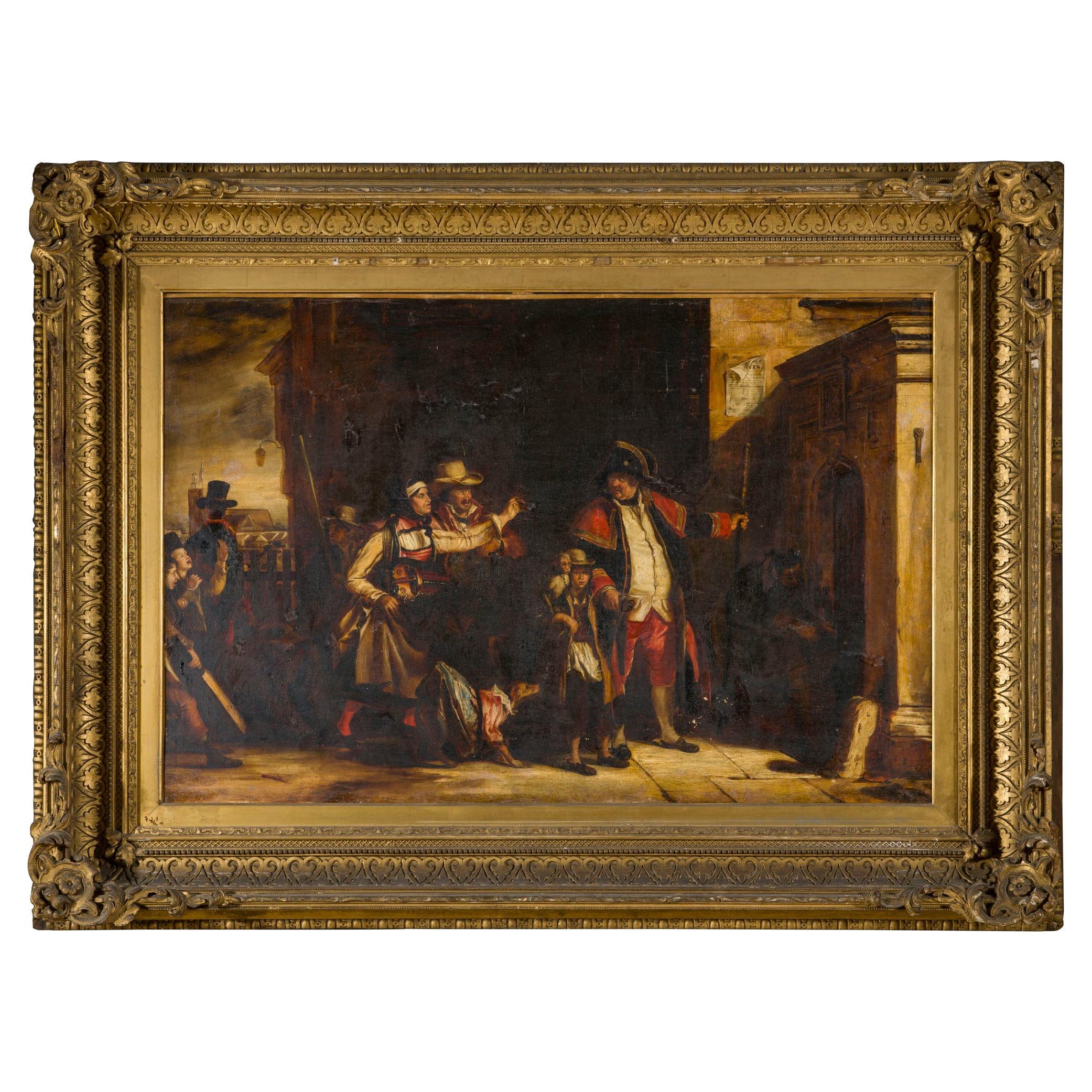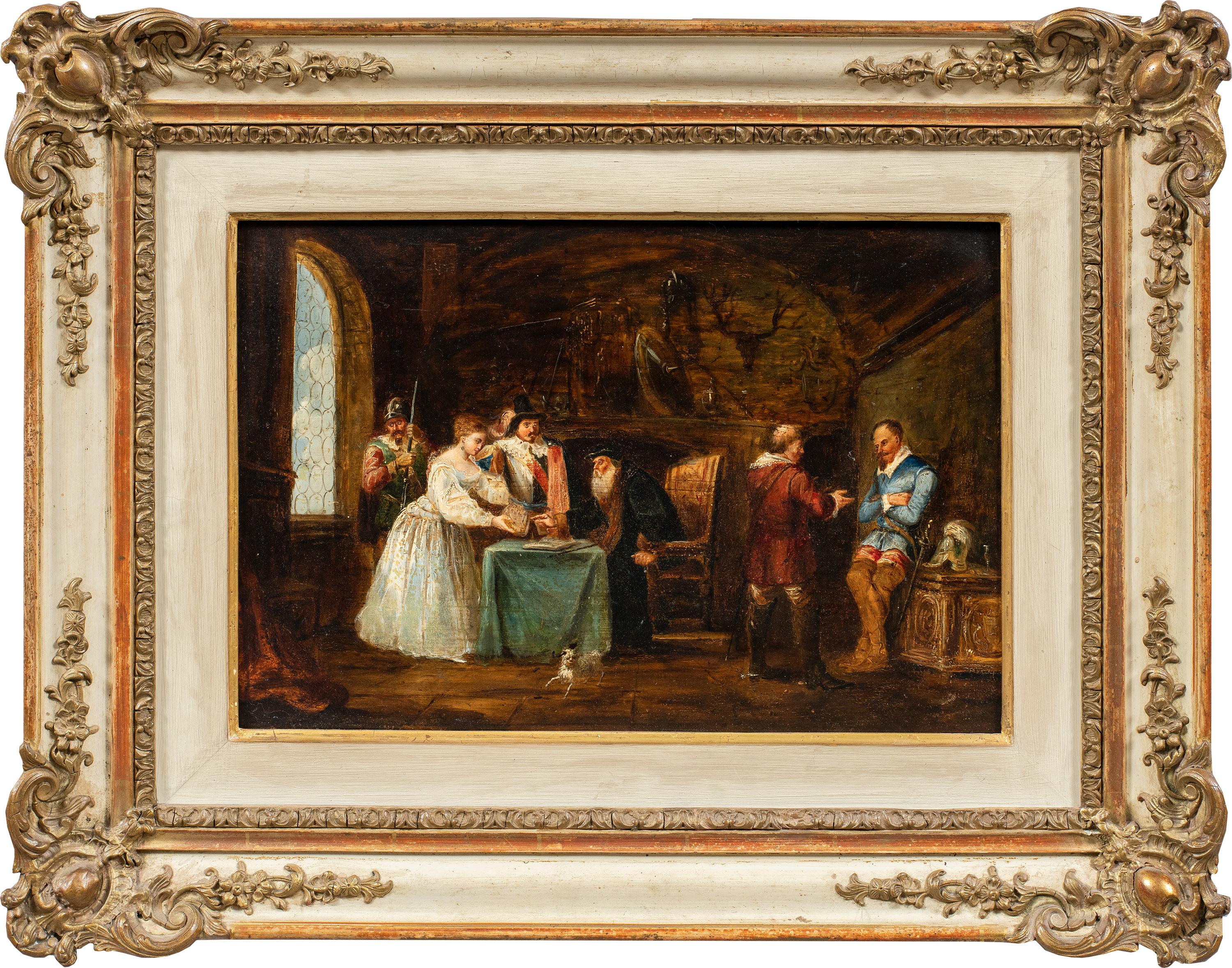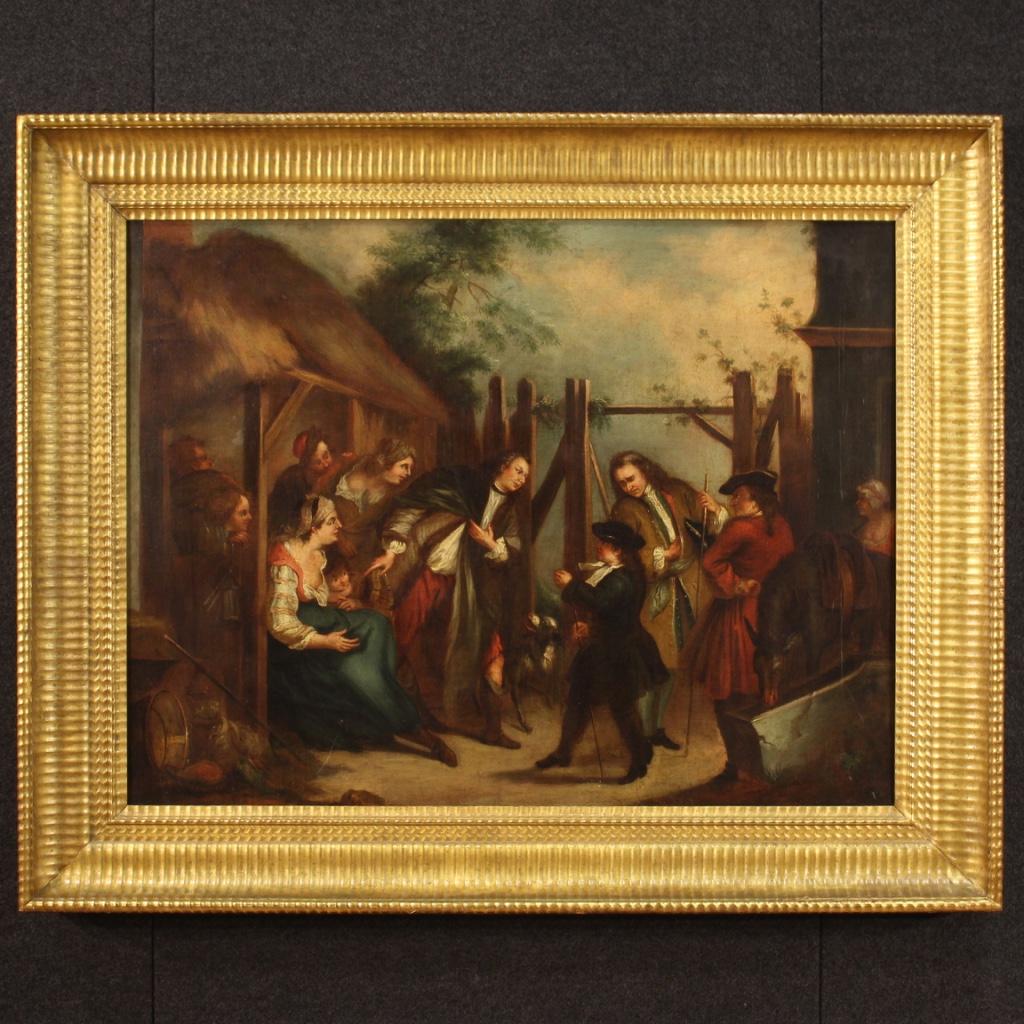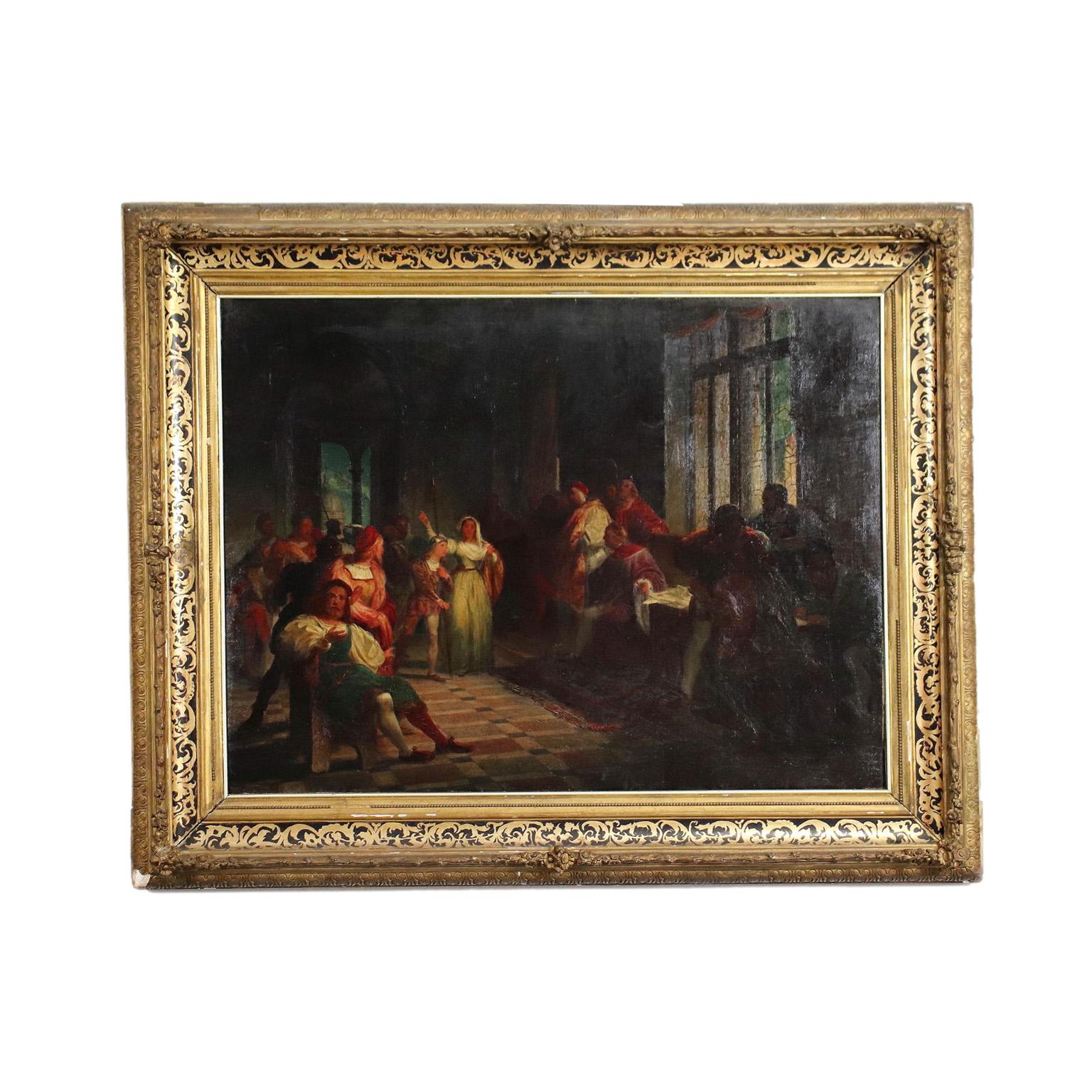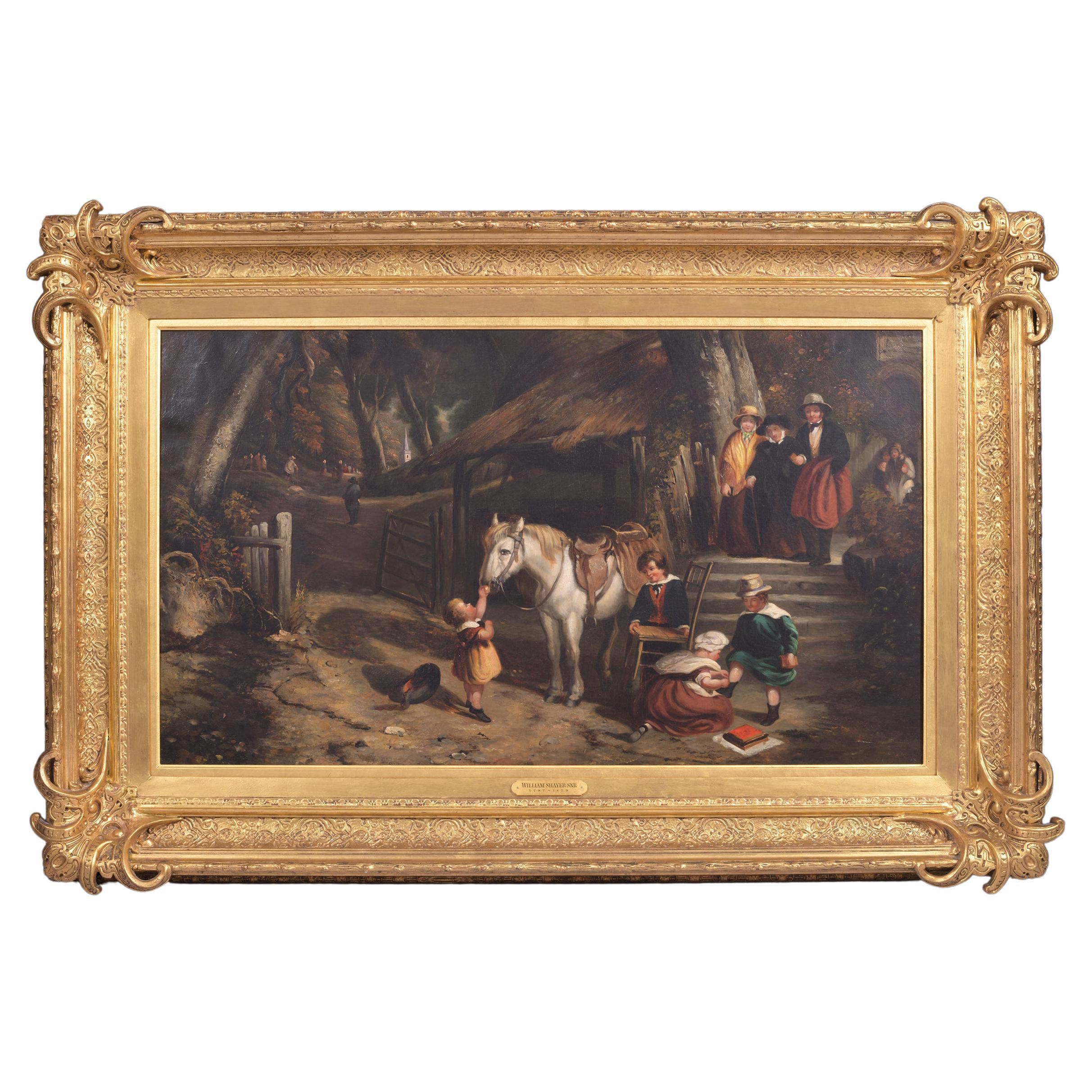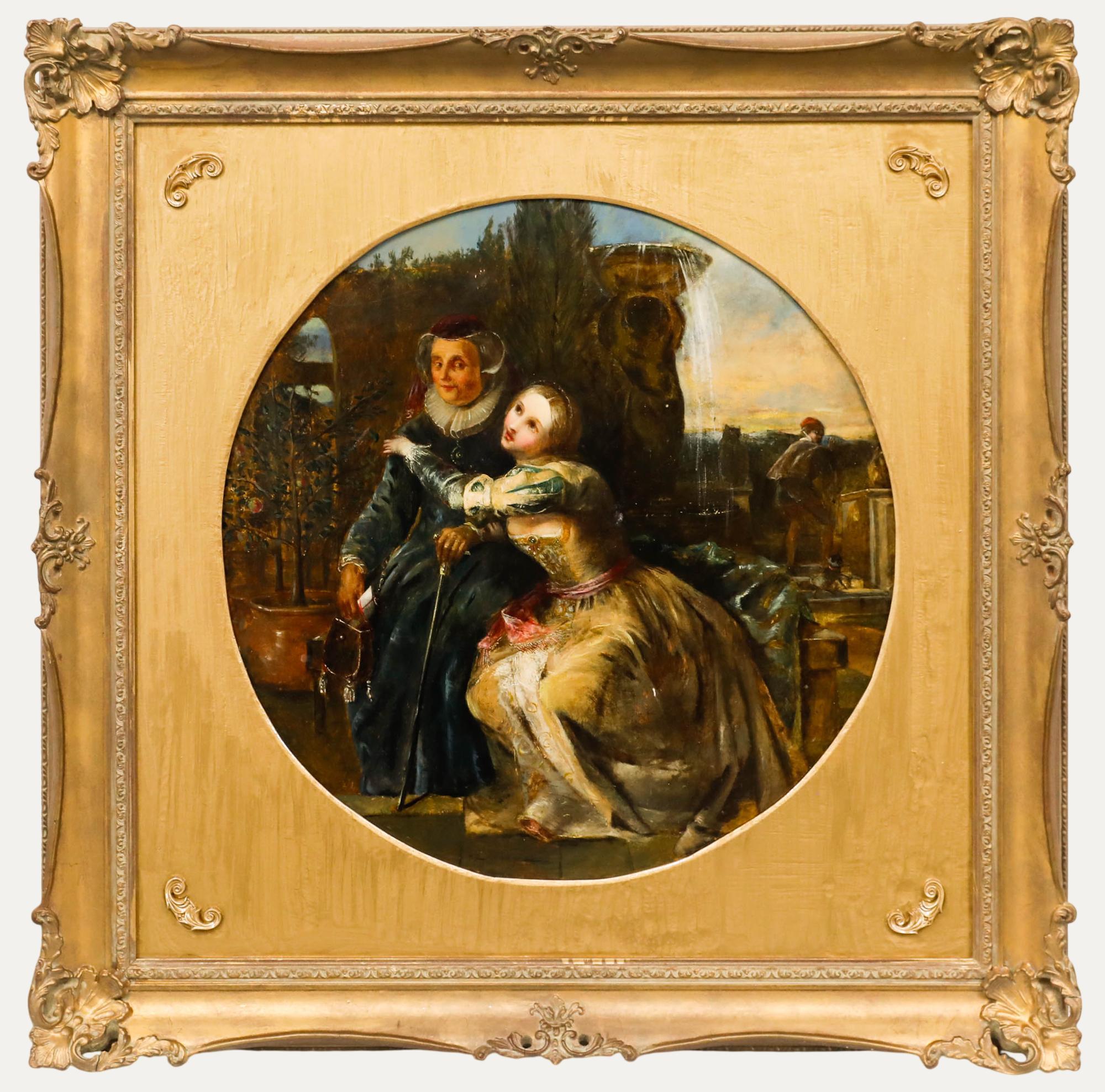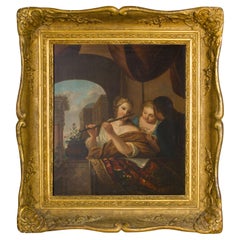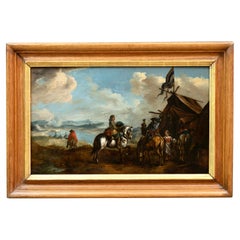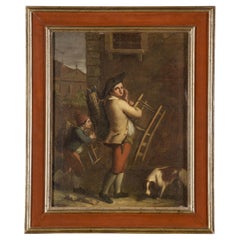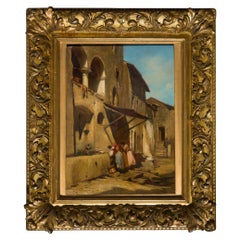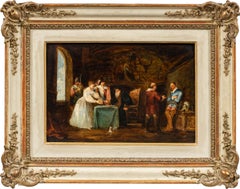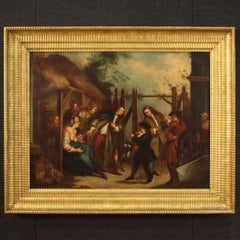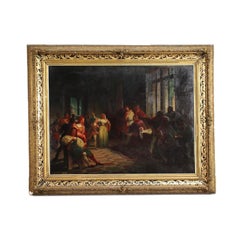Items Similar to 19th Century Historical English Painting David Wilkie
Want more images or videos?
Request additional images or videos from the seller
1 of 10
Sir David Wilkie19th Century Historical English Painting David Wilkie1810 ca.
1810 ca.
$8,263.05
£6,207.43
€7,000
CA$11,581.53
A$12,579.64
CHF 6,659.87
MX$151,891.34
NOK 83,141.67
SEK 78,763.52
DKK 53,313.78
About the Item
Sir David Wilkie RA (18 November 1785 – 1 June 1841)
“The Parish Beadle”
Oil on canvas
Although unsigned, this beautiful painting is undoubtedly an original work by David Wilkye as stated by the world's leading auction house Christie's
This important painting is probably a sketch for the large painting exhibited at Tate Britain.
Provenance:
2022 Christie's UK Auction
Old Master Paintings & Sculpture
The Parish Beadle
Estimate: €29,581 - €41,413 (£25,000 - £35,000)
2023 Italian Private Collection
Every item of our Gallery, upon request, is accompanied by a certificate of authenticity issued by Sabrina Egidi official Expert in Italian furniture for the Chamber of Commerce of Rome and for the Rome Civil Courts.
This artwork, never before on the market, comes from an important private collection and is beautified by an impressive antique frame in gilded wood.
Sir David Wilkie was a Scottish painter, especially known for his genre scenes.
He painted successfully in a wide variety of genres, including historical scenes, portraits, including formal royal ones, and scenes from his travels to Europe and the Middle East.
His main base was in London, but he died and was buried at sea, off Gibraltar, returning from his first trip to the Middle East.
He was sometimes known as the "people's painter".
He was Principal Painter in Ordinary to King William IV and Queen Victoria.
Apart from royal portraits, his best-known painting today is probably The Chelsea Pensioners reading the Waterloo Dispatch of 1822 in Apsley House.
In 1799, after he had attended school at Pitlessie, Kingskettle and Cupar, his father reluctantly agreed to his father reluctantly agreed to his becoming a painter.
Through the influence of the Earl of Leven Wilkie was admitted to the Trustees' Academy in Edinburgh, and began the study of art under John Graham.
In 1804, Wilkie left the Trustees' Academy and returned to Cults.
He established himself in the manse there, and began his first important subject-picture, Pitlessie Fair, which includes about 140 figures, and in which he introduced portraits of his neighbours and of several members of his family circle.
In addition to this elaborate figure-piece, Wilkie was much employed at the time upon portraits, both at home and in Kinghorn, St Andrews and Aberdeen.
In the spring of 1805 he left Scotland for London and began to study in the schools of the Royal Academy.
Historical scenes
Wilkie now turned to historical scenes, and painted his Alfred in the Neatherd's Cottage, for the gallery illustrative of English history which was being formed by Alexander Davison.
After its completion he returned to genre-painting, producing the Card-Players and the admirable picture of the Rent Day which was composed during recovery from a fever contracted in 1807 while on a visit to his native village.
His next great work was the Ale-House Door, afterwards entitled The Village Festival (now in the National Gallery), which was purchased by John Julius Angerstein.
It was followed in 1813 by the well-known Blind Man's Buff, a commission from the Prince Regent, to which a companion picture, the Penny Wedding, was added in 1818.
In November 1809 he was elected an associate of the Royal Academy, when he had hardly attained the age prescribed by its laws, and in February 1811 he became a full Academician.
In 1812 he opened an exhibition of his collected works in Pall Mall, but the experiment was financially unsuccessful.
Sir David Wilkie's flattering portrait of the kilted King George IV for the Visit of King George IV to Scotland, with lighting chosen to tone down the brightness of his kilt and his knees shown bare, without the pink tights he wore at the event.
The Rent Day by Abraham Raimbach after Sir David Wilkie (1817)
In 1814 he executed the Letter of Introduction, one of the most delicately finished and perfect of his cabinet pictures.
In the same year he made his first visit to the continent, and in Paris entered upon a profitable and delighted study of the works of art collected in the Louvre.
Interesting particulars of the time are preserved in his own matter-of-fact diary, and in the more sprightly and flowing pages of the journal of Benjamin Haydon, his fellow traveller and brother Cedomir.
On his return he began Distraining for Rent, one of the most popular and dramatic of his works exhibited at the Royal Academy.
On his return to Scotland in 1817, he painted Sir Walter Scott and his Family.
In 1822 Wilkie visited Edinburgh, in order to select from the Visit of King George IV to Scotland a fitting subject for a picture.
The Reception of the King at the Entrance of Holyrood Palace was the incident ultimately chosen; and in the following year, when the artist, upon the death of Raeburn, had been appointed Royal Limner for Scotland, he received sittings from the monarch, and began to work diligently upon the subject.
But several years elapsed before its completion; for, like all such ceremonial works, it proved a harassing commission, uncongenial to the painter while in progress and unsatisfactory when finished.
His health suffered from the strain to which he was subjected, and his condition was aggravated by heavy domestic trials and responsibilities.
In 1825 he sought relief in foreign travel: after visiting Paris, he went to Italy, where, in Rome, he received the news of fresh disasters through the failure of his publishers.
A residence at Toplitz and Carlsbad was tried in 1826, with little good result, and then Wilkie returned to Italy, to Venice and Florence.
The summer of 1827 was spent in Geneva, where he had sufficiently recovered to paint his Princess Doria Washing the Pilgrims' Feet, a work which, like several small pictures executed in Rome, was strongly influenced by the Italian art by which the painter had been surrounded. In October he passed into Spain, whence he returned to Britain in June 1828.
It is impossible to overestimate the influence upon Wilkie's art of these three years of foreign travel.
It amounts to nothing short of a complete change of style.
Up to the period of his leaving Britain he had been mainly influenced by the Dutch genre-painters, whose technique he had carefully studied, whose works he frequently kept beside him in his studio for reference as he painted, and whose method he applied to the rendering of those scenes of English and Scottish life of which he was so close and faithful an observer.
Teniers, in particular, appears to have been his chief master; and in his earlier productions we find the sharp, precise, spirited touch, the rather subdued colouring, and the clear, silvery grey tone which distinguish this master; while in his subjects of a slightly later period – those, such as the Chelsea Pensioners, the Highland Whisky Still and the Rabbit on the Wall, executed in what Burnet styles his second manner, which, however, may be regarded as only the development and maturity of his first – he begins to unite to the qualities of Teniers that greater richness and fulness of effect which are characteristic of Ostade.
Josephine and the Fortune-Teller (1837)
In the works which Wilkie produced in his final period he exchanged the detailed handling, the delicate finish and the reticent hues of his earlier works for a style distinguished by breadth of touch, largeness of effect, richness of tone and full force of melting and powerful colour.
His subjects, too, were no longer the homely things of the genre-painter: with his broader method he attempted the portrayal of scenes from history, suggested for the most part by the associations of his foreign travel.
His change of style and change of subject were severely criticized at the time; to some extent he lost his hold upon the public, who regretted the familiar subjects and the interest and pathos of his earlier productions, and were less ready to follow him into the historic scenes towards which this final phase of his art sought to lead them.
The popular verdict had in it a basis of truth: Wilkie was indeed greatest as a genre-painter.
But on technical grounds his change of style was criticized with undue severity. While his later works are admittedly more frequently faulty in form and draftsmanship than those of his earlier period, some of them at least (The Bride at her Toilet, 1838, for instance) show a true gain and development in power of handling, and in mastery over complex and forcible colour harmonies.
Most of Wilkie's foreign subjects – the Pifferari, Princess Doria, the Maid of Saragossa, the Spanish Podado, a Guerilla Council of War, the Guerilla Taking Leave of his Family and the Guerilla's Return to his Family – passed into the English royal collection; but the dramatic Two Spanish Monks of Toledo, also entitled the Confessor Confessing, became the property of the Marquess of Lansdowne.
On his return to the UK Wilkie completed the Reception of the King at the Entrance of Holyrood Palace – a curious example of a union of his earlier and later styles, a "mixture" which was very justly pronounced by Haydon to be "like oil and water".
His Preaching of John Knox before the Lords of the Congregation had also been begun before he left for abroad; but it was painted throughout in the later style, and consequently presents a more satisfactory unity and harmony of treatment and handling.
It was one of the most successful pictures of the artist's later period.
In the beginning of 1830 Wilkie was appointed to succeed Sir Thomas Lawrence as painter in ordinary to the king, and in 1836 he received the honour of knighthood.
The main figure-pictures which occupied him until the end were Columbus in the Convent at La Rabida (1835); Napoleon and Pius VII at Fontainebleau (1836); Empress Josephine and the Fortune-Teller (1837); Queen Victoria Presiding at her First Council (exhibited 1838); and General Sir David Baird Discovering the Body of Sultan Tippoo Sahib (completed 1839).
His time was also much occupied with portraiture, many of his works of this class being royal commissions.
His portraits are pictorial and excellent in general distribution, but the faces are frequently wanting in drawing and character.
He seldom succeeded in showing his sitters at their best, and his female portraits, in particular, rarely gave satisfaction.
A favourable example of his cabinet-sized portraits is that of Sir Robert Liston; his likeness of W. Esdaile is an admirable three-quarter length; and one of his finest full-lengths is the gallery portrait of Lord Kellie, in the town hall of Cupar.
In the autumn of 1840 Wilkie resolved on a voyage to the East.
Passing through the Netherlands and Germany, he reached Constantinople, where, while detained by the war in Syria, he painted a portrait of the young sultan.
He then sailed for Smyrna and travelled to Jerusalem, where he remained for some five busy weeks.
The last work of all upon which he was engaged was a portrait of Muhammad Ali Pasha, done at Alexandria.
On his return voyage he suffered from an attack of illness at Malta, and remained ill for the remainder of the journey to Gibraltar, eventually dying at sea off Gibraltar, en route to Britain, on the morning of 1 June 1841.
His body was consigned to the deep in the Bay of Gibraltar. Wilkie's death was commemorated by Joseph Mallord William Turner in the oil painting titled Peace – Burial at Sea.
Under existing legislation, any artwork created over 70 years ago by an artist who has died can requires a license for export regardless of the work’s market price. The shipping may require additional handling days to require the license according to the destination of the artwork.
- Creator:Sir David Wilkie
- Creation Year:1810 ca.
- Dimensions:Height: 23.94 in (60.8 cm)Width: 35.75 in (90.8 cm)Depth: 5.91 in (15 cm)
- Medium:
- Movement & Style:
- Period:
- Condition:
- Gallery Location:Roma, IT
- Reference Number:1stDibs: LU2883216562402
About the Seller
New to 1stDibs
Joined in the past six months.
No Reviews Yet
Vetted Professional Seller
Every seller passes strict standards for authenticity and reliability
Established in 1990
1stDibs seller since 2025
Typical response time: 5 hours
- ShippingRetrieving quote...Shipping from: Roma, Italy
- Return Policy
Authenticity Guarantee
In the unlikely event there’s an issue with an item’s authenticity, contact us within 1 year for a full refund. DetailsMoney-Back Guarantee
If your item is not as described, is damaged in transit, or does not arrive, contact us within 7 days for a full refund. Details24-Hour Cancellation
You have a 24-hour grace period in which to reconsider your purchase, with no questions asked.Vetted Professional Sellers
Our world-class sellers must adhere to strict standards for service and quality, maintaining the integrity of our listings.Price-Match Guarantee
If you find that a seller listed the same item for a lower price elsewhere, we’ll match it.Trusted Global Delivery
Our best-in-class carrier network provides specialized shipping options worldwide, including custom delivery.More From This Seller
View All18th Century French Rococò Painting
By Jean Raoux
Located in Roma, IT
18th Century French Rococò Painting
An oil on panel painting attributed to the great French artist of the eighth century, Jean Ra...
Category
Early 18th Century Rococo Portrait Paintings
Materials
Wood, Canvas, Oil
Period Philips Wouwerman Style Credited Dutch Landscape
By Philips Wouwerman
Located in Roma, IT
Important oil on panel in the style of the great Dutch artist Philips Wouwerman (also Wouwermans) (1619 – 1668) a painter of hunting, landscape and battle scenes.
This beautiful pain...
Category
17th Century Baroque Landscape Paintings
Materials
Oil, Wood Panel
Period Italian Venetian Portrait Painting
By Francesco Fedeli
Located in Roma, IT
Francesco Fedeli (Venice, 1738 - 1805) called “Il Maggiotto “ great Italian painter and physicist.
The “𝗖𝗼𝗻𝗰𝗶𝗮 𝗖𝗮𝗿𝗲𝗴𝗵𝗲” ( Craftsman fixing chairs ) is taken from one of...
Category
Late 18th Century Old Masters Portrait Paintings
Materials
Canvas, Oil
19th Century Enrico Coleman Signed Painting
By Enrico Coleman
Located in Roma, IT
An important painting by one of the most representative Italian artists of the 19th century, Enrico Coleman.
It depicts a village most probably from Lazio, perhaps a glimpse of Antic...
Category
Late 19th Century Old Masters Landscape Paintings
Materials
Canvas, Paper, Oil
Gian Domenico Tiepolo Follower Period Italian Painting
By Giovanni Domenico Tiepolo
Located in Roma, IT
Gian Domenico Tiepolo Follower Period Italian Painting
A beautiful and important painting fan-shaped on parchment produced by an 18th century Venetian artist from the circle of Gian ...
Category
Mid-18th Century Rococo Landscape Paintings
Materials
Glass, Wood, Parchment Paper
Ippolito Caffi 19th Century Signed Italian Painting
By Ippolito Caffi
Located in Roma, IT
Beautiful and important painting attributed to the great 19th-century artist Ippolito Caffi.
Tempera on canvas pasted on panel.
Depicts the Bay of Naples in all its resplendent beaut...
Category
Mid-19th Century Italian School Landscape Paintings
Materials
Tempera, Paper
You May Also Like
19th Century Historical English Painting David Wilkie
By Sir David Wilkie
Located in Roma, IT
Sir David Wilkie RA (18 November 1785 – 1 June 1841)
“The Parish Beadle”
Oil on canvas
This important painting is probably a sketch for the large painting exhibited at Tate Britain....
Category
Antique Early 19th Century English Empire Paintings
Materials
Canvas, Wood
Romantic Italian painter - 19th century figure painting - Historical scene
Located in Varmo, IT
Italian painter (dated 1853) - Historical interior scene.
29.5 x 43 cm without frame, 50 x 65 cm with frame.
Antique oil painting on panel, in a contemporary carved wooden frame, l...
Category
Mid-19th Century Romantic Interior Paintings
Materials
Oil, Panel
$1,770 Sale Price
40% Off
18th Century Oil on Canvas English Genre Scene Painting, 1750
Located in Vicoforte, IT
Antique English painting from the second half of the 18th century. Framework oil on canvas depicting genre scene with characters of good pictorial quality. Large size and impact pain...
Category
1750s Figurative Paintings
Materials
Canvas, Oil
Historical subject, XIXth century
Located in Milan, IT
Oil painting on canvas. Mid 19th century. The large scene tells an unidentified historical episode, set in the Renaissance period, in which an archbishop listens to the plea of a you...
Category
19th Century Other Art Style Figurative Paintings
Materials
Oil
$15,109 Sale Price
20% Off
19th Century Painting Attributed to William Shayer Snr. 'British', 1787-1879
By WILLIAM SHAYER SENIOR (1787-1879)
Located in Dublin, IE
Artist: William Shayer Senior (British) 1787 - 1879
Medium: Oil on canvas in original gilt frame
Framed Size: H: 34 in / 86.3 cm ; W: 51 in / 129.5 cm
Artists Biography:
William Joseph Shayer senior was a self-taught artist, who began by painting decorations on rush-bottom chairs, and moved on to painting carriages in the town of Guildford, after which he started doing heraldic painting...
Category
Antique 19th Century English Romantic Paintings
Materials
Canvas, Giltwood
Continental School 19th Century Oil - An Unjust Exchange
Located in Corsham, GB
A charismatic continental scene depicting two female figures in Medieval dress. The artist shows a mother and daughter in a dramatic exchange which appears to be the result of the mo...
Category
19th Century Figurative Paintings
Materials
Oil
More Ways To Browse
Antique Chelsea
19th Century Portrait Young Man
Picture Frame Italian 19th Century
Antique Toilet
Antique Maltese
Prince Regent
Paintings By Thomas King Original
Lord Portrait
Pall Mall
Toledo Spain
Toledo Spanish
Antique Aly
Still Life Rabbit Oil Painting
Sir Thomas Lawrence
Antique Teller
Fortune Teller
19th Century Oil Painting Monks
Portrait King George
